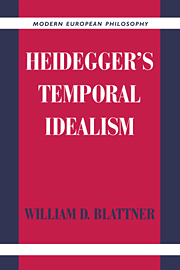Book contents
- Frontmatter
- Contents
- Acknowledgments
- A Note on Sources
- Introduction. Ontology, Phenomenology, and Temporality
- 1 Care as the Being of Dasein
- 2 Originary Temporality
- 3 World-Time and Time-Reckoning
- 4 The Ordinary Conception of Time and Disengaged
- 5 Heidegger's Temporal Idealism
- Conclusion. The Consequences of the Failure of Heidegger's Temporal Idealism
- Bibliography
- Index
Conclusion. The Consequences of the Failure of Heidegger's Temporal Idealism
Published online by Cambridge University Press: 05 June 2012
- Frontmatter
- Contents
- Acknowledgments
- A Note on Sources
- Introduction. Ontology, Phenomenology, and Temporality
- 1 Care as the Being of Dasein
- 2 Originary Temporality
- 3 World-Time and Time-Reckoning
- 4 The Ordinary Conception of Time and Disengaged
- 5 Heidegger's Temporal Idealism
- Conclusion. The Consequences of the Failure of Heidegger's Temporal Idealism
- Bibliography
- Index
Summary
We can divide the labors of Being and Time into three broad sets: an innovative array of ontological categories, prominent in which is a technical development of an ontology of the human that had been emerging within the existentialist tradition; an attempt to link ontology decisively with the philosophy of time; and a novel conception of a philosophy of being. The first set of labors – the new ontological categories – are undoubtedly the most successful of Being and Time. Heidegger uses a broadly phenomenological methodology in order to ground his categories of the occurrent, the available, and Dasein. He devotes greatest attention to Dasein: he develops a well-worked-out version of some of the basic ideas of the existentialist tradition, spins them into a general antinaturalism (existentialist dualism), and uses this in turn to criticize many aspects of the received philosophical tradition. But all along he avers that this dimension of his project is only preparatory. His ultimate goal is his philosophy of being. What I mean by that opaque but common term is this: Heidegger aims to set out an account of being, to understand its articulation into traditional ontological conceptions, such as “what-being” and “that-being,” to grasp its connection with Dasein, and perhaps most importantly to come to terms intellectually with the very distinction between being and entities, the Ontological Difference.
- Type
- Chapter
- Information
- Heidegger's Temporal Idealism , pp. 277 - 310Publisher: Cambridge University PressPrint publication year: 1999



